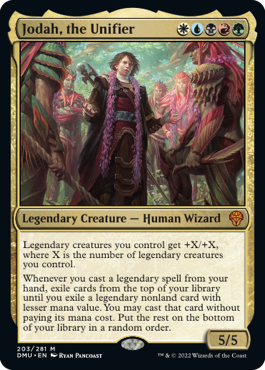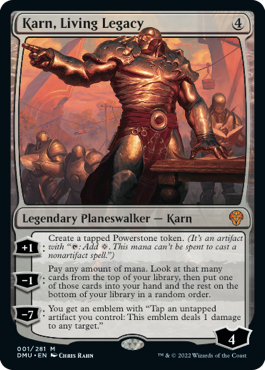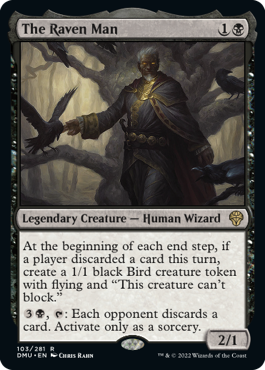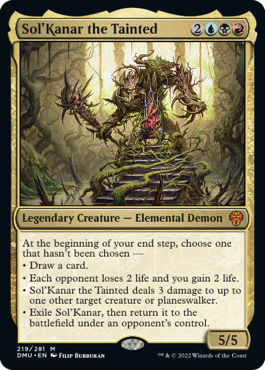Dominaria United States of Design, Part 3
For the last two weeks (in Part 1 and Part 2), I've been telling card-by-card design stories from Dominaria United. I have more stories to tell, so today is the third and final part.
Jodah, the Unifier

Back in 1999, Jeff Grubb wrote a book called The Gathering Dark whose protagonist was a man named Jodah. Jodah has a blood relation to Urza and Mishra and was born a bit after the Brothers' War. Jodah was referenced on cards for the first time in Planar Chaos when we made a riff on Urza's Avenger, which we called Jodah's Avenger. Jodah would finally show up on a card in Dominaria as a legendary creature (Jodah, Archmage Eternal). We were looking for a character to be a five-color legendary creature, and we liked that he was a character that had played a major role in stories outside the card sets but never had a card.
Since we were returning to Dominaria, and Jodah had proven to be a popular character, we wanted to give him another card. All we knew going in was that he had to be five colors. Here's our first attempt:
Jodah, Coalition Envoy (version #1)
WUBRG
Legendary Creature — Human Wizard
5/5
Unite – 3: Choose target creature you control that doesn't share a creature type with CARDNAME. Put a +1/+1 counter on CARDNAME and it becomes a creature type of that creature in additional to its other types.
Creatures you control that share a creature type with CARDNAME get +1/+1 for each +1/+1 counter on CARDNAME.
In the story, Jodah was playing peacemaker, bringing together various denizens of Dominaria to help fight against the Phyrexians, so we wanted a design that captured that flavor. The first iteration makes use of a mechanic called unite, which was a monstrosity variant that tied you thematically to another creature by gaining their creature type. The card would then mechanically make that matter in some way. In Jodah's case, he acts as a lord that pumps any creature that shares a creature type with him.
Jodah, Coalition Envoy (version #2)
WUBRG
Legendary Creature — Human Wizard
5/5
Vigilance
T: CARDNAME gains Unite 0 – 1 of a creature type of target creature you control that doesn't share a creature type with CARDNAME until end of turn.
Creatures you control that share a creature type with CARDNAME get +1/+1 for each +1/+1 counter on CARDNAME.
We have a bad habit in early design of not always spelling out in text how a mechanic works, so I'm not quite sure what "Unite 0 – 1" is trying to convey. I assume that we were trying to make it require less mana to unite with other creatures but added a tap to limit how often it could happen. I think at this point we were experimenting with being able to use unite more than once (unlike monstrosity, the mechanic it's tweaking), but the handed-off version would go back to it being a one-time thing.
Jodah, Coalition Envoy (version #3)
WUBRG
Legendary Creature — Human Wizard
5/5
Legendary creatures you control get +1/+1 for each legendary creature you control.
Unite went away, so we had to come up with a different way to play up Jodah uniting the denizens of Dominaria. This design borrows a lot from a card I made back in Exodus called Coat of Arms.
I recognized that creature type decks were popular (this is before Onslaught turned up creature type themes to make them tournament viable), but outside of a few main creature types, we hadn't given players the tools to make them strong enough to play at things like Friday Night Magic. Coat of Arms was my attempt to make a generic card to pump up whatever creature type players wanted to build a deck around. The card went on to be a fan favorite, and from time to time, we make new designs riffing on it. Jodah's tweak was obviously that it cared about the supertype legendary rather than a creature subtype.
Hall of Legends (version #4)
5
Legendary Artifact
Legendary creatures you control get +1/+1 for each legendary creature you control.
This led to the design team asking, "If we're making a Coat of Arms card for legendary creatures, why not just make it an artifact like Coat of Arms?"
Jodah, Coalition Envoy (version #5)
WUBRG
Legendary Creature — Human Wizard
5/5
Legendary creatures you control get +1/+1 for each legendary creature you control.
Grandeur — X, Discard another card named CARDNAME: Search your library for a legendary creature with mana value X or less, put it onto the battlefield, then shuffle your library. Activate only as a sorcery.
The design team quickly realized that no, they wanted Jodah, and this was a cool effect for him to have. I believe this version was during early set design when they were experimenting with having grandeur in the set. (Vision Design had messed around with common legendary creatures with grandeur.) His grandeur ability let him tutor legendary creatures. By the way, one of the nice things about designing a five-color creature is every ability is available to you.
Jodah, Coalition Envoy (version #6)
WUBRG
Legendary Creature — Human Wizard
5/5
Legendary creatures you control get +1/+1 for each legendary creature you control.
Whenever another legendary creature you control dies, you may exile it. You may cast that card for as long as it remains exiled. It costs an additional {2} to cast this way.
Grandeur left the file, so the design team tried a new second ability, allowing you to recast dead legendary creatures you control. I think this wasn't exciting enough, so the finished card taps into another popular mechanic, cascade. The combination of Coat of Arms and cascade on the same card proved to make for an exciting mix of abilities.
Here's Jodah's art description:
Setting: Dominaria
Color: Creature associated with all colors of mana
Location: Among the Ruins of Kroog (pgs. 221-222) in Yavimayan rainforest
Action: Jodah (p. 373), an immortal and powerful wizard, has just encountered an expedition of YAVIMAYAN ELVES (pgs. 226-230). He stands among them in an attempt to gain their favor and trust so they can help him and his allies in the upcoming war. He should look diplomatic and maybe even has put on a piece of Yavimaya clothing in order to show his good will.
Focus: Jodah
Mood: Diplomatic
Karn, Living Legacy

Karn was a character Michael Ryan and I created for the Weatherlight Saga. We wanted an artifact member of the crew, and we were interested in a "gentle giant" archetype, so we combined them to make Karn.
For those wondering where Karn got his name, it was inspired by the word "cairn" (a mound of rough stones built as a memorial or landmark, typically on a hilltop or skyline). Interestingly, Karn first showed up as a Vanguard card.
His card mechanic was designed before we even knew the Weatherlight crew was going to be on the Vanguard cards. Only Karn and Hanna had any relationship with artifacts, and animating them felt more Karn than Hanna, so I made that card Karn. Karn would finally get a normal Magic card in Urza's Saga (Karn, Silver Golem), a legendary creature. He got his first planeswalker card in New Phyrexia (Karn Liberated), his second one in Dominaria (Karn, Scion of Urza), and his third one in War of the Spark (Karn, the Great Creator).
Karn plays a big role in Dominaria United, so we knew we needed to make him a new card. Sometimes in design you make an early version, and each iteration is just a tweak advancing toward the end product. Other times, the design can bounce around from version to version. Karn was the latter.
Here's our first attempt:
Karn, Golem Guy (version #1)
4
Legendary Planeswalker — Karn
Loyalty – 3
+1: Create a Powerstone token.
-2: Target artifact becomes a 4/4 artifact creature.
-7: Create a colorless artifact token with indestructible and "4: Destroy target nonland permanent."
For The Brothers' War, we planned to use Powerstones (a key element of The Brothers' War story), so the Vision Design team for Dominaria United was interested in putting a bunch in the set as a "throw forward" to the next set. Both Dominaria United and The Brothers' War take place on Dominaria, so it seemed like a cool way to connect the two sets.
By the time the set was finished, Powerstones were cut down to appearing on a single card, Karn. The reason Powerstones are not spelled out is that we didn't know how they were going to work yet. The first version of this card stayed mainly in areas that Karn had done before, animating artifacts and destroying things.
Karn, Golem Guy (version #2)
4
Legendary Planeswalker — Karn
Loyalty – 3
+2: Create a Powerstone token.
0: You may sacrifice an artifact you control. If you do, you may cast an instant or sorcery card from your graveyard with mana value less than or equal to the sacrificed artifact's mana value. If that spell would be put into a graveyard this turn, exile it.
-X: Target artifact you control becomes a copy of target nontoken creature with mana value X, except it's an artifact in addition to its other types and isn't legendary if that creature is legendary.
The next version of Karn went in a different direction (well, other than making Powerstones). The new 0 ability did involve artifacts but allowed you to cast instants and sorcery spells out of your graveyard, a new ability for Karn. The -X ability allowed you to turn artifacts into copies of creatures you controlled. This design was seeing how far it could push things while still technically interacting with artifacts.
Karn, Golem Guy (version #3)
4
Legendary Planeswalker — Karn
Loyalty – 4
+2: Create a Powerstone token.
+2: Sacrifice an artifact. If you do, draw a card.
-2: Create a 0/0 colorless Construct artifact creature token with "This creature gets +1/+1 for each artifact you control."
The next version of Karn shifted yet again. It still made Powerstones but could now turn your artifacts into cards or allow them to pump up Construct creature tokens. The design is a little odd to me, as the second +2 ability and the -2 ability seem to work against one another. The card drawing ability wants you to use up your artifacts, while the token maker wants you to build them up.
Karn, Golem Guy (version #4)
4
Legendary Planeswalker — Karn
Loyalty – 3
At the beginning of your upkeep, Karn's loyalty becomes the number of artifacts you control.
+2: Create a Powerstone token.
-1: Draw a card.
-7: Noncreature artifacts you control become 4/4 artifact creatures until end of turn.
The next iteration changed it up again, although the Powerstone creation stayed. This version has a static ability and three loyalty abilities. My gut says that something went wrong here, as three- and four-ability planeswalkers require slightly different art needs, so my guess is someone made a four-ability version without realizing that it wasn't what the art was going to support.
This design played around with having a static ability that defines Karn's loyalty, which ties into his Powerstone-making ability. It's quirky, but novel. His ultimate again returned to animating noncreature artifacts, a staple Karn ability.
The final version was again a complete change, minus the Powerstone making. The -1 ability is still card drawing but now allows you to dig deeper with the more mana you can spend. Tying a loyalty ability to mana is not something we do that often. The ultimate allows Karn to turn artifacts into direct damage, something kind of new for Karn.
Finally, here's Karn's art description:
Setting: Dominaria
Color: Planeswalker associated with no color of mana
Location: In a jungle clearing being excavated. We can see trees in the background.
Action: Show us Karn, a living machine seen on p. 360. He stands examining ancient Thran artifacts (p. 285-287) that have just been excavated. Maybe we see dirt still surrounding them or atop them. Maybe he is reaching out to brush off the artifact in front of him, or is standing with his back to them, pondering their purpose.
Focus: Karn
Mood: Excavator
The Raven Man

The Raven Man first showed up in stories associated with Liliana in Magic Origins. He was a mysterious character whom we knew little about. There was even some doubt about whether he existed. Well, he does, and Dominaria United is finally bringing him to card form. Let's see how he was designed.
The Raven Man (version #1)
B
Legendary Creature — Spirit
1/1
Whenever another creature enters the battlefield under your control, if it entered from a graveyard or you cast it from a graveyard, put two +1/+1 counters on CARDNAME. When CARDNAME dies, create a number of 1/1 black Bird creature tokens with flying equal to its power.
From the very first incarnation, the designers wanted to tie The Raven Man to Birds. (I mean, he is called The Raven Man.) This version encourages you to build around getting or casting creatures out of the graveyard. The Birds became a little secondary in this design as they only happened as a consolation for losing The Raven Man.
Minister of Lim-Dûl (version #2)
2B
Legendary Creature — Human Cleric
2/2
When CARDNAME enters the battlefield, or is promoted, sacrifice a creature.
2BB: Promote 2 to The Raven Man. (If this creature isn't legendary, put two +1/+1 counters on it, it becomes legendary, and it gets a new name.)
Whenever a nontoken creature you control dies, create a number of 1/1 black Bird creature tokens with flying equal to its power.
The next version tied into a mechanic that early set design explored, an ability called promote. Promote, which was an evolved version of unite, works like monstrosity, except it also makes the creature legendary and gives it a new name.
Set Design took several legendary creatures in the file and added promote. This version made it a little easier to create Birds, as any creature that dies under your control will make a Bird creature token. I'll note that this card was designed before the design team was up to speed on the details of The Raven Man (although obviously they realized he was somehow affiliated with Lim-Dûl).
Lim-Dûl's Disciple (version #3)
B
Creature — Human Cleric
1/1
Lifelink
2B: Promote 1 to The Raven Man. (If this creature isn't legendary, put a +1/+1 counter on it, it becomes legendary, and it gets a new name.)
Whenever a nontoken creature you control dies, if CARDNAME is legendary, create a number of 1/1 black Bird creature tokens with flying equal to its power.
This incarnation is a tweaked version of the last attempt. Mostly the card was cheaper, smaller, and tied his Bird-making ability to being The Raven Man. You'll notice over time that he's started to drift away mechanically from the malevolence the character is known for.
Lim-Dûl's Disciple (version #4)
BBB
Creature — Human Cleric
2/2
Whenever a nontoken creature you control dies, create a number of 1/1 black Bird creature tokens with flying equal to its power.
2BBB: Promote 2 to The Raven Man. (If this creature isn't legendary, put two +1/+1 counters on it, it becomes legendary, and it gets a new name.)
1B, T: Each player sacrifices a nontoken creature. Activate only as a sorcery.
This version started beefing up The Raven Man. He was more expensive to cast. Had more power and toughness. His promote number was bigger. He also gained an activated ability which can mess with the opponent and trigger your Bird making.
Lim-Dûl, the Raven Man (version #5)
BB
Legendary Creature — Human Cleric
2/2
At the beginning of the end step, if three or more creatures you controlled died this turn, return CARDNAME from your graveyard to the battlefield.
Whenever a player discards a creature card or sacrifices a non-token creature, create a 1/1 black Raven creature tokens with flying.
Now we see that the card was moving closer to the feel of The Raven Man from the stories. He thrives off other players' pain. The card also gained a way to get itself back from the graveyard. I assume this was to represent how The Raven Man never seems to die.
The Raven Man (version #6)
BB
Legendary Creature — Human Cleric
2/4
Whenever an opponent discards a card, create a 1/1 black Bird creature token with flying.
{o3oB}, T: Each opponent discards a card. Activate only as a sorcery.
This version gave you a way to force a discard as well as reward you for it happening. It also lost the reanimation clause. The final version ended up turning the Bird making into an end-of-turn trigger that only gives you one Bird per turn, as the previous version proved in playtest to be a little too much. He also had to shrink a little in size but went from BB to 1B. Sadly, I could not find the art description for this card.
Sol'Kanar the Tainted

Our next character has a long gap between his first and second appearance. Sol'kanar the Swamp King appeared in Legends in the summer of 1994.
I didn't realize he was still alive, but I guess he is a Demon. Here's his first version:
Sol'Kanar, King of Corondor (version #1)
2UBR
Legendary Creature — Demon
5/5
Menace
Whenever you cast a blue spell, loot.
Whenever you cast a black spell, untargeted raise dead.
Whenever you cast a red spell, ping.
I always like the from-the-hip, shortcut versions you see in early design. "Loot" means draw and discard a card. "Raise dead" means returning a creature card from the graveyard to hand. "Ping" means deal 1 damage to any target. This version kept Sol'Kanar in the same three colors as his original version and rewarded you with an in-color effect for casting each of the three colors. Note that multicolor spells can trigger multiple effects. The card was still a 5/5 for 2UBR like the original, but swampwalk was exchanged for menace, as swampwalk is no longer an effect we do.
Sol'Kanar, King of Corondor (version #2)
2UBR
Legendary Creature — Demon
5/5
Menace
Whenever you cast a blue spell, draw two cards, then discard two cards.
Whenever you cast a black spell, return a creature card from your graveyard to your hand.
Whenever you cast a red spell, return an instant or sorcery card from your graveyard to your hand.
This version made the blue effect stronger, the black effect targeted, and changed the red effect from direct damage to getting back an instant or sorcery. Now all three abilities are more card oriented.
Sol'Kanar, King of Corondor (version #3)
UBR
Legendary Creature — Demon
5/3
Whenever you cast a blue spell, CARDNAME gains hexproof until end of turn.
Whenever you cast a black spell, CARDNAME gains indestructible until end of turn.
Whenever you cast a red spell, CARDNAME gains trample and haste until end of turn.
This next version made Sol'Kanar cheaper but lost 2 toughness and menace. The color triggers now granted abilities, in color, to Sol'Kanar.
Sol'Kanar, King of Corondor (version #4)
1UBR
Legendary Creature — Demon
3/3
Haste
Whenever CARDNAME is blocked, gain control of all the blocking creature for as long as CARDNAME is on the battlefield. then remove CARDNAME from combat.
Whenever CARDNAME deals combat damage to a player, exile the top card of their library. If it is a land, you may put it on the battlefield under your control. Otherwise, you may cast it without paying its mana cost.
This iteration made Sol'Kanar more about attacking. He had haste, a blocking trigger, and a saboteur trigger. If he hit you, he would steal your spells, but if you blocked, he would steal your creatures.
Sol'Kanar, King of Corondor (version #5)
1UBR
Legendary Creature — Demon
2/3
Haste
Whenever CARDNAME becomes blocked by one or more creatures, gain control of those creatures for as long as you control CARDNAME. Remove CARDNAME from combat.
Whenever CARDNAME deals combat damage to a player, draw that many cards.
Casting the opponent's spells was a little too much, so the saboteur ability changed to card draw.
Sol'Kanar, Tainted Guardian (version #6)
2UBR
Legendary Creature — Demon
4/6
At the beginning of combat on your turn, each opponent chooses a creature or planeswalker they control. You gain control of those permanents until end of turn. Untap them. They gain haste until end of turn.
The next version of Sol'Kanar became a repeating Threaten. To avoid the issue of always taking the biggest thing, the effect let the opponent choose what you take.
Sol'Kanar, Tainted Maro (version #7)
2UBR
Legendary Creature — Demon
3/5
At the beginning of your end step, choose one that hasn't been chosen —
• CARDNAME deals 5 damage to up one target creature or planeswalker.
• Scry 2, then draw a card.
• Each opponent loses 3 life and you gain 3 life.
• Exile CARDNAME, then return it to the battlefield under an opponent's control.
The seventh version tapped into a template we first saw on the enchantment Demonic Pact from Magic Origins. You're given a series of effects, and each turn you have to choose something you haven't chosen yet. The final version changed some of the effects, but the most important one, the control change that you usually choose last, stayed on the card.
Here is Sol'Kanar's art description:
Setting: Dominaria
Color: Legendary creature associated with blue, black, and red mana
Location: Interior of a palace overgrown with vines, tendrils, hanging moss, and swamp stuff.
Intent: Before being corrupted by dark magic, this creature was an elemental like Multani, on p. 375. Some similarity in their visual design would be cool.
Action: SOL'KANAR, a DEMON shaped out of mud, ichor, and swamp plants, looms terrifyingly over a throne much too small for him. In one huge hand he holds a MACE made of corrupted, rotten natural materials, bristling with bones and long thorns.
Focus: SOL'KANAR
Mood: Corrupted nature
Happily Ever After
That's all the story time I have for today. I hope these last three weeks of card-by-card design stories from Dominaria United have been fun. If you have any feedback on any of the articles, on any of the cards I talked about, or on Dominaria United as a set, please feel free to email me or contact me through any of my social media accounts (Twitter, Tumblr, Instagram, and TikTok).
Join me next week on Tuesday when I talk about the challenges of designing for other IPs.
Until then, may these cards bring joy to your game.
#965: DMU Vision Design with Ethan Fleischer
#965: DMU Vision Design with Ethan Fleischer
30:59
In this podcast, I sit down with Ethan Fleischer, the lead vision designer of Dominaria United, to talk about the set's vision design.
#966: Rise & Fall of Blocks, Part 1
#966: Rise & Fall of Blocks, Part 1
36:49
This is part one of a two-part series talking about the history of blocks.
- Episode 964 Concurrency
- Episode 963 Build-Arounds
- Episode 962 My Wizards Origin Story

